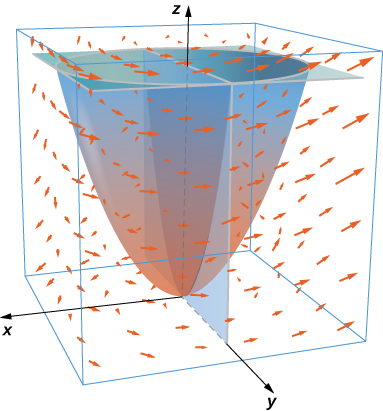16.7E: Mazoezi ya Sehemu ya 16.7
- Page ID
- 178922
Katika mazoezi ya 1 - 6, bila kutumia theorem ya Stokes, kuhesabu moja kwa moja mzunguko wa\(curl \, \vecs F \cdot \vecs N\) juu ya uso uliopewa na mzunguko muhimu karibu na mipaka yake, kwa kuzingatia wote ni oriented clockwise.
1. \(\vecs F(x,y,z) = y^2\,\mathbf{\hat i} + z^2\,\mathbf{\hat j} + x^2\,\mathbf{\hat k}\);\(S\) ni sehemu ya kwanza ya ndege\(x + y + z = 1\).
2. \(\vecs F(x,y,z) = z\,\mathbf{\hat i} + x\,\mathbf{\hat j} + y\,\mathbf{\hat k}\);\(S\) ni hemisphere\(z = (a^2 - x^2 - y^2)^{1/2}\).
- Jibu
- \(\displaystyle \iint_S (curl \, \vecs F \cdot \vecs N) \, dS = \pi a^2\)
3. \(\vecs F(x,y,z) = y^2\,\mathbf{\hat i} + 2x\,\mathbf{\hat j} + 5\,\mathbf{\hat k}\);\(S\) ni hemisphere\(z = (4 - x^2 - y^2)^{1/2}\).
4. \(\vecs F(x,y,z) = z\,\mathbf{\hat i} + 2x\,\mathbf{\hat j} + 3y\,\mathbf{\hat k}\);\(S\) ni hemisphere ya juu\(z = \sqrt{9 - x^2 - y^2}\).
- Jibu
- \(\displaystyle \iint_S (curl \, \vecs F \cdot \vecs N) \, dS = 18 \pi\)
5. \(\vecs F(x,y,z) = (x + 2z)\,\mathbf{\hat i} + (y - x)\,\mathbf{\hat j} + (z - y)\,\mathbf{\hat k}\);\(S\) ni kanda ya triangular yenye vertices\((3, 0, 0), \, (0, 3/2, 0),\) na\((0, 0, 3).\)
6. \(\vecs F(x,y,z) = 2y\,\mathbf{\hat i} + 6z\,\mathbf{\hat j} + 3x\,\mathbf{\hat k}\);\(S\) ni sehemu ya paraboloid\(z = 4 - x^2 - y^2\) na ni juu\(xy\) -ndege.
- Jibu
- \(\displaystyle \iint_S (curl \, \vecs F \cdot \vecs N) \, dS = -8 \pi\)
Katika mazoezi ya 7 - 9, tumia theorem ya Stokes kutathmini\(\displaystyle \iint_S (curl \, \vecs F \cdot \vecs N) \, dS\) kwa mashamba ya vector na uso.
7. \(\vecs F(x,y,z) = xy\,\mathbf{\hat i} - z\,\mathbf{\hat j}\)na\(S\) ni uso wa mchemraba\(0 \leq x \leq 1, \, 0 \leq y \leq 1, \, 0 \leq z \leq 1\), ila kwa uso ambapo\(z = 0\) na kutumia kitengo cha nje vector kawaida.
8. \(\vecs F(x,y,z) = xy\,\mathbf{\hat i} + x^2 \,\mathbf{\hat j} + z^2 \,\mathbf{\hat k}\); na\(C\) ni makutano ya paraboloid\(z = x^2 + y^2\) na ndege\(z = y\), na kutumia vector nje ya kawaida.
- Jibu
- \(\displaystyle \iint_S (curl \, \vecs F \cdot \vecs N) \, dS = 0\)
9. \(\vecs F(x,y,z) = 4y\,\mathbf{\hat i} + z \,\mathbf{\hat j} + 2y \,\mathbf{\hat k}\); na\(C\) ni makutano ya nyanja\(x^2 + y^2 + z^2 = 4\) na ndege\(z = 0\), na kutumia vector nje ya kawaida.
10. Matumizi Theorem Stokes 'kutathmini\(\displaystyle \int_C \big[2xy^2z \, dx + 2x^2yz \, dy + (x^2y^2 - 2z) \, dz\big],\) ambapo\(C\) ni Curve iliyotolewa na\(x = \cos t, \, y = \sin t, \, 0 \leq t \leq 2\pi\), traversed katika mwelekeo wa kuongeza\(t.\)
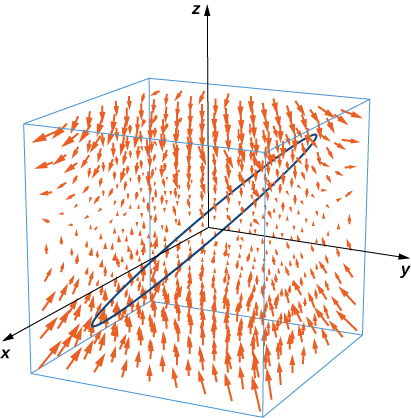
- Jibu
- \(\displaystyle \int_C \vecs F \cdot dS = 0\)
11. [T] Use a computer algebraic system (CAS) and Stokes’ theorem to approximate line integral \(\displaystyle \int_C (y \, dx + z \, dy + x \, dz),\) where \(C\) is the intersection of plane \(x + y = 2\) and surface \(x^2 + y^2 + z^2 = 2(x + y)\), traversed counterclockwise viewed from the origin.
12. [T] Use a CAS and Stokes’ theorem to approximate line integral \(\displaystyle \int_C (3y\, dx + 2z \, dy - 5x \, dz),\) where \(C\) is the intersection of the \(xy\)-plane and hemisphere \(z = \sqrt{1 - x^2 - y^2}\), traversed counterclockwise viewed from the top—that is, from the positive \(z\)-axis toward the \(xy\)-plane.
- Answer
- \(\displaystyle \int_C \vecs F \cdot dS = - 9.4248\)
13. [T] Use a CAS and Stokes’ theorem to approximate line integral \(\displaystyle \int_C [(1 + y) \, z \, dx + (1 + z) x \, dy + (1 + x) y \, dz],\) where \(C\) is a triangle with vertices \((1,0,0), \, (0,1,0)\), and \((0,0,1)\) oriented counterclockwise.
14. Use Stokes’ theorem to evaluate \(\displaystyle \iint_S curl \, \vecs F \cdot dS,\) where \(\vecs F(x,y,z) = e^{xy} cos \, z\,\mathbf{\hat i} + x^2 z\,\mathbf{\hat j} + xy\,\mathbf{\hat k}\), and \(S\) is half of sphere \(x = \sqrt{1 - y^2 - z^2}\), oriented out toward the positive \(x\)-axis.
- Answer
- \(\displaystyle \iint_S \vecs F \cdot dS = 0\)
15. [T] Use a CAS and Stokes’ theorem to evaluate \(\displaystyle \iint_S (curl \, \vecs F \cdot \vecs N) \, dS,\) where \(\vecs F(x,y,z) = x^2 y\,\mathbf{\hat i} + xy^2 \,\mathbf{\hat j} + z^3 \,\mathbf{\hat k}\) and \(C\) is the curve of the intersection of plane \(3x + 2y + z = 6\) and cylinder \(x^2 + y^2 = 4\), oriented clockwise when viewed from above.
16. [T] Use a CAS and Stokes’ theorem to evaluate \(\displaystyle \iint_S curl \, \vecs F \cdot dS,\) where \(\vecs F(x,y,z) = \left( \sin(y + z) - yx^2 - \dfrac{y^3}{3}\right)\,\mathbf{\hat i} + x \, \cos (y + z) \,\mathbf{\hat j} + \cos (2y) \,\mathbf{\hat k}\) and \(S\) consists of the top and the four sides but not the bottom of the cube with vertices \((\pm 1, \, \pm1, \, \pm1)\), oriented outward.
- Answer
- \(\displaystyle \iint_S curl \, \vecs F \cdot dS = 2.6667\)
17. [T] Use a CAS and Stokes’ theorem to evaluate \(\displaystyle \iint_S curl \, \vecs F \cdot dS,\) where \(\vecs F(x,y,z) = z^2\,\mathbf{\hat i} + 3xy\,\mathbf{\hat j} + x^3y^3\,\mathbf{\hat k}\) and \(S\) is the top part of \(z = 5 - x^2 - y^2\) above plane \(z = 1\) and \(S\) is oriented upward.
18. Use Stokes’ theorem to evaluate \(\displaystyle \iint_S (curl \, \vecs F \cdot \vecs N) dS,\) where \(\vecs F(x,y,z) = z^2\,\mathbf{\hat i} + y^2\,\mathbf{\hat j} + x\,\mathbf{\hat k}\) and \(S\) is a triangle with vertices \((1, 0, 0), \, (0, 1, 0)\) and \((0, 0, 1)\) with counterclockwise orientation.
- Answer
- \(\displaystyle \iint_S (curl \, \vecs F \cdot \vecs N)dS = -\dfrac{1}{6}\)
19. Use Stokes’ theorem to evaluate line integral \(\displaystyle \int_C (z \, dx + x \, dy + y \, dz),\) where \(C\) is a triangle with vertices \((3, 0, 0), \, (0, 0, 2),\) and \((0, 6, 0)\) traversed in the given order.
20. Use Stokes’ theorem to evaluate \(\displaystyle \int_C \left(\dfrac{1}{2} y^2 \, dx + z \, dy + x \, dz \right),\) where \(C\) is the curve of intersection of plane \(x + z = 1\) and ellipsoid \(x^2 + 2y^2 + z^2 = 1\), oriented clockwise from the origin.
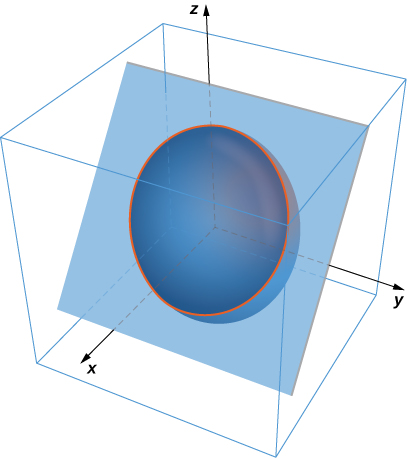
- Jibu
- \(\displaystyle \int_C \left(\dfrac{1}{2} y^2 \, dx + z \, dy + x \, dz \right) = - \dfrac{\pi}{4}\)
21. Matumizi Stokes 'theorem kutathmini\(\displaystyle \iint_S (curl \, \vecs F \cdot \vecs N) dS,\) wapi\(\vecs F(x,y,z) = x\,\mathbf{\hat i} + y^2\,\mathbf{\hat j} + ze^{xy}\,\mathbf{\hat k}\) na\(S\) ni sehemu ya uso\(z = 1 - x^2 - 2y^2\) na\(z \geq 0\), oriented kinyume chake.
22. Matumizi Stokes 'theorem kwa ajili ya uwanja vector\(\vecs F(x,y,z) = z\,\mathbf{\hat i} + 3x\,\mathbf{\hat j} + 2z\,\mathbf{\hat k}\) ambapo\(S\) ni uso\(z = 1 - x^2 - 2y^2, \, z \geq 0\),\(C\) ni mduara wa mipaka\(x^2 + y^2 = 1\), na\(S\) ni oriented katika chanya\(z\) -mwelekeo.
- Jibu
- \(\displaystyle \iint_S (curl \, \vecs F \cdot \vecs N)dS = -3\pi\)
23. Matumizi Stokes 'theorem kwa ajili ya uwanja vector\(\vecs F(x,y,z) = - \dfrac{3}{2} y^2\,\mathbf{\hat i} - 2 xy\,\mathbf{\hat j} + yz\,\mathbf{\hat k}\), ambapo\(S\) ni kwamba sehemu ya uso wa ndege\(x + y + z = 1\) zilizomo ndani ya pembetatu\(C\)\((1, 0, 0), \, (0, 1, 0),\) na\((0, 0, 1),\) vipeo na kupita kinyume chake kama kutazamwa kutoka juu.
24. Njia fulani iliyofungwa\(C\) katika ndege\(2x + 2y + z = 1\) inajulikana kwa mradi kwenye mduara wa kitengo\(x^2 + y^2 = 1\) katika\(xy\) -ndege. Hebu\(C\) kuwa mara kwa mara na basi\(\vecs R(x,y,z) = x\,\mathbf{\hat i} + y\,\mathbf{\hat j} + z\,\mathbf{\hat k}\). Tumia theorem Stokes 'kutathmini\(\displaystyle \int_C(c \,\mathbf{\hat k} \times \vecs R) \cdot dS.\)
- Jibu
- \(\displaystyle \int_C (c \,\mathbf{\hat k} \times \vecs R) \cdot dS = 2\pi c\)
25. Matumizi Stokes 'theorem na basi\(C\) kuwa mipaka ya uso\(z = x^2 + y^2\) na\(0 \leq x \leq 2\) na\(0 \leq y \leq 1\) oriented na zaidi inakabiliwa kawaida. Eleza\(\vecs F(x,y,z) = \big(\sin (x^3) + xz\big) \,\mathbf{\hat i} + (x - yz)\,\mathbf{\hat j} + \cos (z^4) \,\mathbf{\hat k}\) na tathmini\(\int_C \vecs F \cdot dS\).
26. Hebu\(S\) kuwa hemisphere\(x^2 + y^2 + z^2 = 4\) na\(z \geq 0\), oriented juu. Hebu\(\vecs F(x,y,z) = x^2 e^{yz}\,\mathbf{\hat i} + y^2 e^{xz} \,\mathbf{\hat j} + z^2 e^{xy}\,\mathbf{\hat k}\) kuwa uwanja wa vector. Tumia theorem Stokes 'kutathmini\(\displaystyle \iint_S curl \, \vecs F \cdot dS.\)
- Jibu
- \(\displaystyle \iint_S curl \, \vecs F \cdot dS = 0\)
27. Hebu\(\vecs F(x,y,z) = xy\,\mathbf{\hat i} + (e^{z^2} + y)\,\mathbf{\hat j} + (x + y)\,\mathbf{\hat k}\) na hebu\(S\) kuwa grafu ya kazi\(y = \dfrac{x^2}{9} + \dfrac{z^2}{9} - 1\) na\(z \leq 0\) oriented ili vector kawaida\(S\) ina chanya y sehemu. Matumizi Theorem Stokes 'kukokotoa muhimu\(\displaystyle \iint_S curl \, \vecs F \cdot dS.\)
28. Tumia theorem ya Stokes kutathmini\(\displaystyle \oint \vecs F \cdot dS,\) wapi\(\vecs F(x,y,z) = y\,\mathbf{\hat i} + z\,\mathbf{\hat j} + x\,\mathbf{\hat k}\) na\(C\) ni pembetatu yenye vipeo\((0, 0, 0), \, (2, 0, 0)\) na\(0,-2,2)\) inaelekezwa kinyume chake wakati unapotazamwa kutoka hapo juu.
- Jibu
- \(\displaystyle \oint \vecs F \cdot dS = -4\)
29. Matumizi ya uso muhimu katika Theorem Stokes 'kwa mahesabu ya mzunguko wa shamba\(\vecs F,\)\(\vecs F(x,y,z) = x^2y^3 \,\mathbf{\hat i} + \,\mathbf{\hat j} + z\,\mathbf{\hat k}\) kote\(C,\) ambayo ni makutano ya silinda\(x^2 + y^2 = 4\) na ulimwengu\(x^2 + y^2 + z^2 = 16, \, z \geq 0\), oriented kinyume chake wakati kutazamwa kutoka juu.
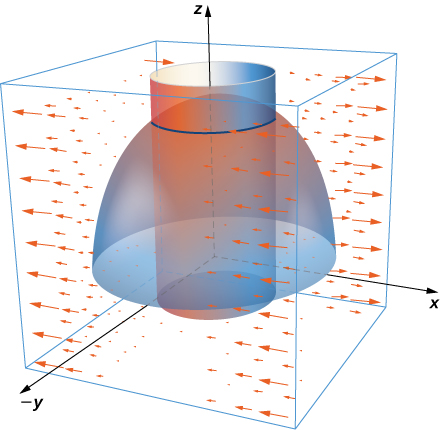
30. Tumia theorem ya Stokes 'kukokotoa\(\displaystyle \iint_S curl \, \vecs F \cdot dS.\) where \(\vecs F(x,y,z) = \,\mathbf{\hat i} + xy^2\,\mathbf{\hat j} + xy^2 \,\mathbf{\hat k}\) and \(S\) is a part of plane \(y + z = 2\) inside cylinder \(x^2 + y^2 = 1\) and oriented counterclockwise.
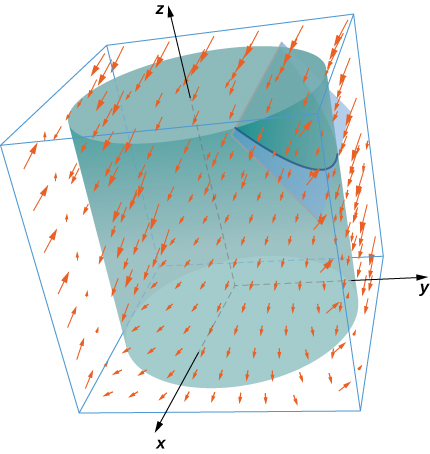
- Jibu
- \(\displaystyle \iint_S curl \, \vecs F \cdot dS = 0\)
31. Tumia theorem ya Stokes kutathmini\(\displaystyle \iint_S curl \, \vecs F \cdot dS,\) wapi\(\vecs F(x,y,z) = -y^2 \,\mathbf{\hat i} + x\,\mathbf{\hat j} + z^2\,\mathbf{\hat k}\) na\(S\) ni sehemu ya ndege\(x + y + z = 1\) katika octant chanya na oriented kinyume chake\(x \geq 0, \, y \geq 0, \, z \geq 0\).
32. Hebu\(\vecs F(x,y,z) = xy\,\mathbf{\hat i} + 2z\,\mathbf{\hat j} - 2y\,\mathbf{\hat k}\) na\(C\) uwe na makutano ya ndege\(x + z = 5\) na silinda\(x^2 + y^2 = 9\), ambayo inaelekezwa kinyume chake wakati inatazamwa kutoka juu. Compute line muhimu ya\(\vecs F\) juu ya\(C\) kutumia Theorem Stokes '.
- Jibu
- \(\displaystyle \iint_S curl \, \vecs F \cdot dS = -36 \pi\)
33. [T] Matumizi CAS na basi\(\vecs F(x,y,z) = xy^2\,\mathbf{\hat i} + (yz - x)\,\mathbf{\hat j} + e^{yxz}\,\mathbf{\hat k}\). Matumizi Stokes 'theorem kukokotoa uso muhimu ya curl\(\vecs F\) juu ya uso\(S\) na mwelekeo ndani yenye mchemraba\([0,1] \times [0,1] \times [0,1]\) na upande wa kulia kukosa.
34. Hebu\(S\) kuwa ellipsoid\(\dfrac{x^2}{4} + \dfrac{y^2}{9} + z^2 = 1\) oriented kinyume na basi\(\vecs F\) kuwa uwanja vector na kazi sehemu ambayo kuendelea sehemu derivatives.
- Jibu
- \(\displaystyle \iint_S curl \, \vecs F \cdot \vecs N = 0\)
35. Hebu\(S\) kuwa sehemu ya paraboloid\(z = 9 - x^2 - y^2\) na\(z \geq 0\). Thibitisha Theorem Stokes 'kwa uwanja vector\(\vecs F(x,y,z) = 3z\,\mathbf{\hat i} + 4x\,\mathbf{\hat j} + 2y\,\mathbf{\hat k}\).
36. [T] Matumizi CAS na Stokes 'theorem kutathmini\(\displaystyle \oint \vecs F \cdot dS,\) kama\(\vecs F(x,y,z) = (3z - \sin x) \,\mathbf{\hat i} + (x^2 + e^y) \,\mathbf{\hat j} + (y^3 - \cos z) \,\mathbf{\hat k}\), ambapo\(C\) ni Curve iliyotolewa na\(x = \cos t, \, y = \sin t, \, z = 1; \, 0 \leq t \leq 2\pi\).
- Jibu
- \(\displaystyle \oint_C \vecs F \cdot d\vecs{r} = 0\)
37. [T] Matumizi CAS na Stokes 'theorem kutathmini\(\vecs F(x,y,z) = 2y\,\mathbf{\hat i} + e^z\,\mathbf{\hat j} - \arctan x \,\mathbf{\hat k}\) na\(S\) kama sehemu ya paraboloid\(z = 4 - x^2 - y^2\) kukatwa na\(xy\) -ndege oriented kinyume.
38. [T] Matumizi CAS kutathmini\(\displaystyle \iint_S curl (F) \cdot dS,\) wapi\(\vecs F(x,y,z) = 2z\,\mathbf{\hat i} + 3x\,\mathbf{\hat j} + 5y\,\mathbf{\hat k}\) na\(S\) ni uso parametrically na\(\vecs r(r,\theta) = r \, \cos \theta \,\mathbf{\hat i} + r \, \sin \theta \,\mathbf{\hat j} + (4 - r^2) \,\mathbf{\hat k} \, (0 \leq \theta \leq 2\pi, \, 0 \leq r \leq 3)\).
- Jibu
- \(\displaystyle \iint_S curl (F) \cdot dS = 84.8230\)
39. Hebu\(S\) kuwa paraboloid\(z = a (1 - x^2 - y^2)\)\(z \geq 0\), kwa,\(a > 0\) wapi idadi halisi. Hebu\(\vecs F(x,y,z) = \langle x - y, \, y + z, \, z - x \rangle\). Kwa thamani gani (s) ya\(a\) (kama ipo)\(\displaystyle \iint_S (\vecs \nabla \times \vecs F) \cdot \vecs n \, dS\) ina thamani yake ya juu?
Kwa mazoezi ya maombi 40 - 41, lengo ni kutathmini\(\displaystyle A = \iint_S (\vecs \nabla \times \vecs F) \cdot \vecs n \, dS,\) wapi\(\vecs F = \langle xz, \, -xz, \, xy \rangle\) na\(S\) nusu ya juu ya ellipsoid\(x^2 + y^2 + 8z^2 = 1\), wapi\(z \geq 0\).
40. Kutathmini muhimu uso juu ya uso rahisi zaidi kupata thamani ya\(A.\)
- Jibu
- \(\displaystyle A = \iint_S (\vecs \nabla \times \vecs F) \cdot \vecs n \, dS = 0\)
41. Tathmini kwa\(A\) kutumia mstari muhimu.
42. Kuchukua paraboloid\(z = x^2 + y^2\)\(0 \leq z \leq 4\), kwa, na kipande kwa ndege\(y = 0\). Hebu\(S\) iwe uso unaoendelea\(y \geq 0\), ikiwa ni pamoja na uso wa mipango katika\(xz\) -ndege. Hebu\(C\) kuwa sehemu ya semicircle na mstari ambayo imefungwa cap\(S\) ya ndege\(z = 4\) na mwelekeo kinyume chake. Hebu\(\vecs F = \langle 2z + y, \, 2x + z, \, 2y + x \rangle\). Tathmini\(\displaystyle \iint_S (\vecs \nabla \times \vecs F) \cdot \vecs n \, dS.\)
